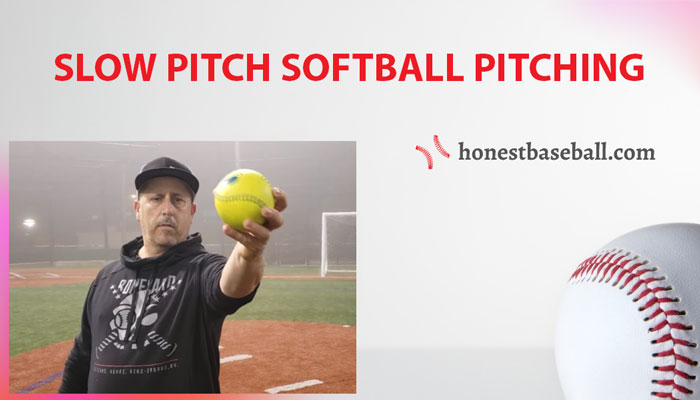After years of experience in the pro baseball career, one thing I found pretty crucial for ballers. And that is adapting different techniques of pitching. The same goes for softball. Slow pitch softball pitching is the key strategy for striking out hard hitters or ensuring at least they missed the hit.
In fast pitching, you emphasize more force or power. On the contrary, in slow pitch, you bet on the spinning rate and rotational axis of the released toss.
Some beginner pitchers are a bit conservative about learning slow pitching as it requires quite a dedication.
However, slowpitch softball pitches can seem like a difficult technique to master, but you can conquer the skill with the right plan and discipline.
I will share with you the plan in this post. You just need to keep the regular action on the ground. Make sure to read till the end.
Types Of Slow Pitch Pitches
It is easy to grasp the basics of pitching slow pitch softball. What makes it more challenging is when you try to learn the different techniques that fall in this pitching style.
In general, all slow pitching approaches are distinguished into three methods – basic underhand, curveball, and knuckleball. Although there are 5 types of slow pitching styles:
- Backspin
- Screwball
- Slider
- Knuckleball
- Curveball
Backspin Straight Pitch
Slow pitch softball pitching backspin is actually the first slow pitch that you should be a master of. Some of my folks also call it power pitch because of its high backspin rate.
With slow backspin pitching, you have to ensure the ball drops steeply from the top of the arc to the striking zone. The unusual arching action makes it hard for batters to square upon.
Another advantage is because of the high backspin rate. The ball eventually deflects off the bat if the batters hit it downward.
It is kind of similar to the backspin principles that we witness in table tennis.
When you apply a backspin shot, and your opponent tries to hit the ball, it goes directly to the net or miss-motion shot because of the spinning. The same is applied to softball.
Slider
Amateurs often get confused and use sliders and screwballs in the same slow pitching style. But the angle or break of these two pitches is completely different.
For delivering a nice sharp break, the slider is a great tossing strategy.
When you release the ball, make sure it rotates slightly to your glove hand side. By turning the axis a little, you can generate Magnus effects.
It is also mandatory to keep the rotation axis horizontal during the flight or track of the ball. Otherwise, it will not break as the pressure on both sides of the ball will be the same.
If you want to learn how to throw a slider in baseball, here is a detailed guide on sliders.
Screwball
Consider it as the companion pitch of the sliders. After polishing up your sliders, you should be working on the screwball. It gives a great advantage to the ballers who already know sliders.
The key difference is unlike sliders, the axis of the screwball breaks to your pitching arm side.
If you are struggling with your sidearm throwing skills in softball, learn how to fix it from the below video.
As a result, the batter has to wait until ½ or ⅓ of the way to understand the ball’s intention.
Because of that, it works both for left and right-handed batters. It allows you a good command of the toss’s designation. I used to try this to disrupt the timing of hard batters.
All other slow pitches are good but what makes it more effective is that the batters cannot predict your pitching.
Knuckleball
Sometimes it is the only slow pitch softball pitching that can get you out of trouble. What makes knuckleball more effective is the airflow around the seams.
The airflow causes differential air pressure on the sides of the ball, which makes the ball move a little after tossing. However, it is predictable by batters most of the time.
Another thing you should keep in mind is that knuckleball takes more arm speed. You will not get the wrist to assist as you get in backspin. So, it will require an extra effort.
You should also ensure that the ball is not rotating too much.
Curveball
It is the opposite style of backspin pitch, meaning you will be throwing the ball with a forward spinning motion. Depending on the left and right-handed batters, the hand movement can be different.
When there is a left-handed batter on the flip side, you should throw the ball with backhand action. And for the right-handed batters, you throw with a forehand motion.
There are different types of curveball tosses, such as knuckle-curve, power curve, and vice-versa.
Slow Pitch Softball Pitching – 3 Important Factors You Should Know
To be the expert in every pitching in slow pitch softball, you should first grab the basics – grip and release, strike zone, and arc.
Pitching Grip/Release
Keep in mind that gripping and releasing methods decide how well your toss will end up, and this is the secret recipe of many successful pitchers.
They influence three main terms of your toss – velocity, accuracy, and duration of the ball in the air. Let’s check out different kinds of gripping methods below.
Strike Zone
Your slow pitch softball pitching becomes more effective once you get a thorough understanding of the strike zone.
A softball strike zone is segmented into three depending on the batter’s height.
Below the chest is considered the top zone. A batter’s waistline is called the middle zone (some may also call it the belt zone). And lastly, the kneecap area or bottom zone.
Understanding/calculating each of them is vital to delivering a good slow pitch.
If you want to know what is the best softball bat used by most hard hitters, check out this Easton MAKO TORQ Helmer review I shared earlier.
Arc
Getting a good grasp on the different arcs is compulsory, especially if you want to learn the ASA or USSSA slow pitch softball pitching tricks. Usually, the arc ranges between 6 to 12 ft. in these leagues. I will share more insights about this some other day.
7 Important Tips For Becoming Master Of Slow Pitch Softball Pitching
Whether you are just starting with softball or planning to strategize your slow pitch softball pitching skills, following the below tips can enhance your pitching skills significantly.
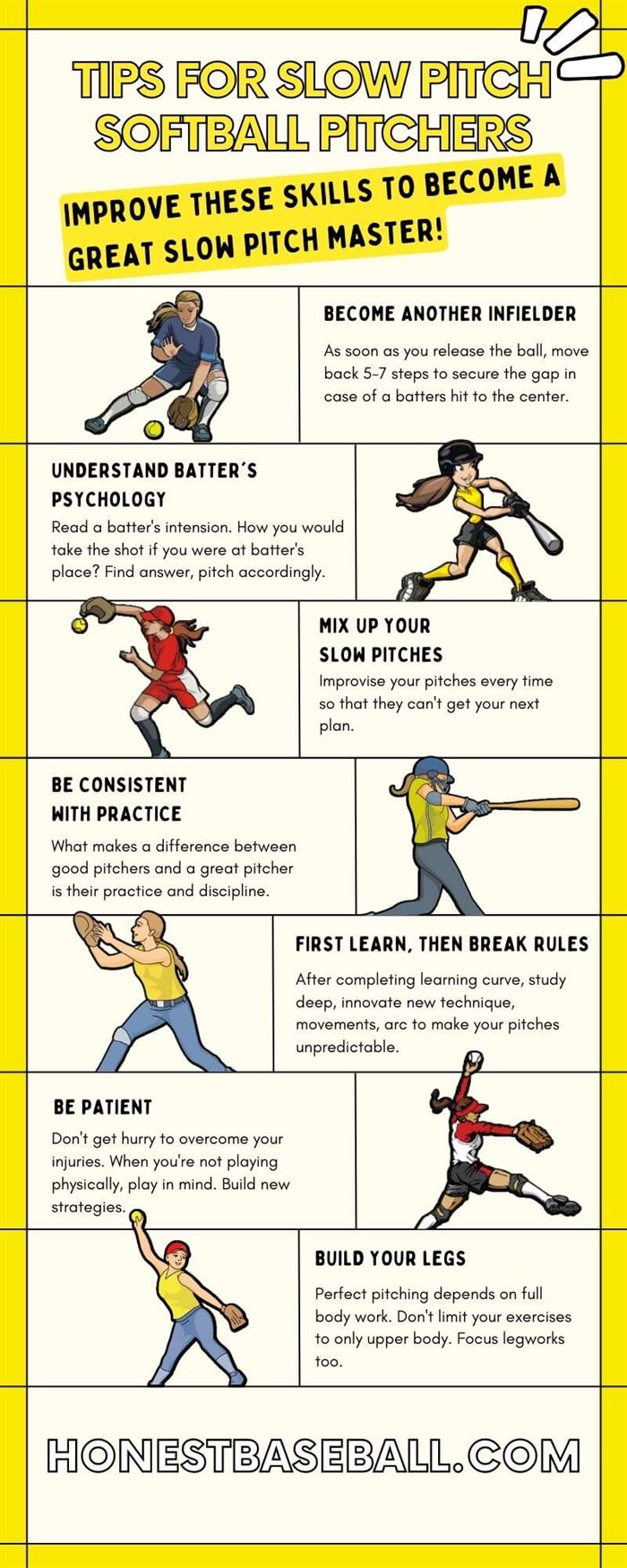
How To Pitch A Slow Pitch Softball
A successful pitch can give you the stadium full of cheer like what we witness with baseball chants. If you do not know what baseball chants are, make sure to read this article to learn why it helps players.
The method of slow pitch varies based on different pitching styles. Below I shared a complete guide about each of them.
How To Slow Pitch Four-seam Backspin
The first and my favorite pitching style is backspin slow pitch softball pitching. Before learning the release method, let’s take a look at how the grip works.
Step 1: Grip Of Backspin
In this method, you should pick a wide grip with your middle and index finger, keeping the fingers close to the axis of the rotation. And then the thumb on the backside should be opposing the seam.

Step 2: Releasing Slow Pitch Backspin
When preparing a backspin power pitch, you should turn your wrist from 90-degree to 0-degree. You can execute a short of the arc by beginning with this hand motion.

During the pinching action, your other fingers and thumb have to make pressure and a quick wrist rotation.
It helps to produce a high rate of spin that results in a good steep drop at the end of the pitch. You also get a favorable deflection angle off of the bat.
“Adult pitchers can generate an average of 1000 rpm of spinning rate when backspinning. ”
One interesting fact you will identify after mastering this slow pitch. Though the back and forehand backspin end up hitting almost a similar area, backhand tosses tend to fly through a higher height than forehand tosses.
How To Slow Pitch Four-seam Slider
Just like the slow backspin pitch, the slider also has a high spinning rate and delivers a sharper break. It actually breaks from the pitching arm side to the glove arm side.
Step 1: Grip Of Slider
Griping for the slider is identical to a four-seam grip. The difference is you should place the thumb a little beside the seam. As a result, you get a better grip.
You may want to change the ring finger for your comfort or to get a better grip. The fun fact is though it is a four-seam slow pitch, there is no use of the pinky finger at all.
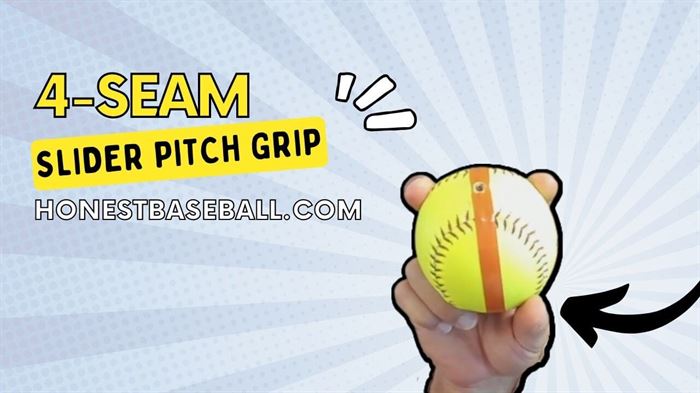
For a slider, you have to throw it by pushing with the thumb. When spinning or creating a rotation, it should be rotating towards the glove side.
Many pitchers start with a wide finger position in the slider. But I found something interesting after years of mastering this pitch.
Using a wider position of the index and middle fingers will cause an inconsistent rotation. This will result in the ball wobbling too much.
And when the rotational action wobbles more than it should, it creates a lot of friction or turbulence on the high-pressure side of the ball. It reduces the amount of breaks.
Step 2: Releasing Slow Pitch Slider
To release a perfect slow pitch slider, pronate your wrist in the glove. It will help you to get shoulder, elbow, and wrist rotation.
Then move your hand back to the hip to generate the force. Your wrist and forearm should be at 90-degree there.
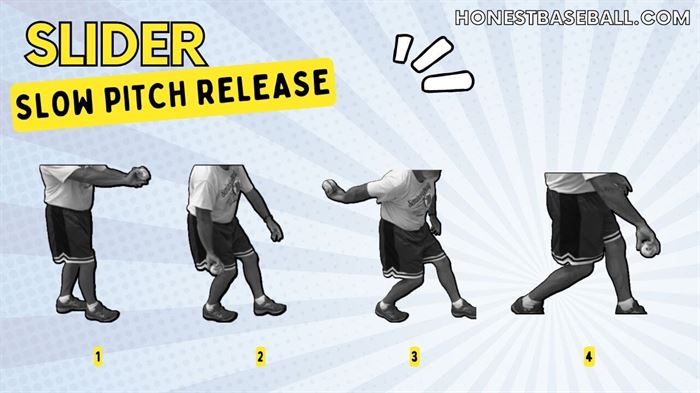
Keep the hand gesture straight when passing through your thigh line. And at the release, make sure to do the same.
In this way, your hand will change the position from 90 to 0 degrees within a certain arc. It gives you a really good backspin rate.
Your middle finger and thumb should also align with the ball’s trajectory.
If you have followed the gesture, the axis will turn slightly to the glove side during the release. Then it ends up with high pressure on your pitching arms side after releasing the ball.
How To Slow Pitch Screwball
Now let’s move on to the next, Screwball. Screwballs are somehow a bit of improvisation of sliders. However, the strategy is slightly different.
Step 1: Grip Of Screwball
As I mentioned earlier, screwball and slider grips are almost the same in terms of gripping. But instead of throwing towards the glove side, you should throw towards the pitching arm side.
Place your index and middle finger all the way across the ball as wide as you can. The wider you place your finger, the more spin rate it will generate.
Then put your thumb pad on the backside. You should place your thumb between the vertical stripe and the seam like the slider.
“Vertical stripe is a straight line on the ball made by pitchers to help them understand about accurate finger placement when gripping.”
Step 2: Releasing Slow Pitch Screwball
Screwball is a comparably easier pitching style for both left-handed and right-handed ballers. What you need to make sure is your ball breaks towards the pitching arm side.
For screwball, you must use the pressure of the ring finger. That means it is not the grip that makes the difference; rather, it is the releasing method that is important in screwball.
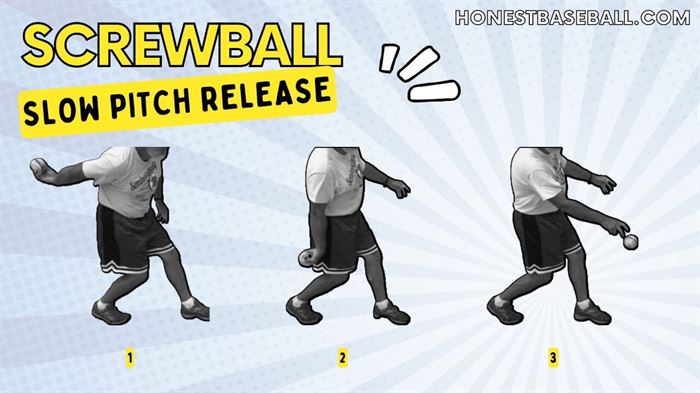
So, first, move your hand back and reach the shoulder height. Keep the angle of your forearm and wrist parallel to 1st base and 3rd base.
Try to catch a 90-degree angle of your hand when going forward for releasing. At the same time, you need to turn your wrist towards the pitching arm side from this point to release.
How To Slow Pitch Four-seam Knuckleball
There are no bells and whistles in the case of the knuckleball. My advice is to use a four-seam palm up method for this.
Step 1: Grip Of Knuckleball
You should place all your four fingers right on the seam, and similarly, on the backside, place the thumb on the end of the seam. Keep a slight distance between the ball and your palm if possible.
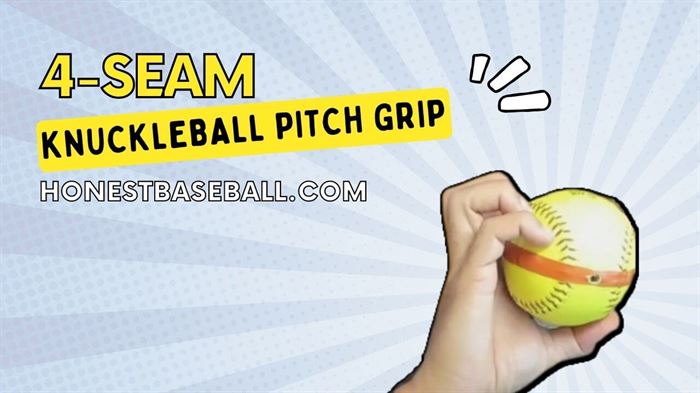
Pitchers with smaller hands might find this a little tough to keep the distance. But don’t worry, it’s not a big deal.
The main thing is that there should be firm contact on the ball with the fingertips and the thumb.
Remember, you are not applying any wrist action in knuckleball when you pitch the ball.
Because if you use wrist action, it will create spinning, which ruins the whole purpose of the knuckleball pitching.
There is a big difference between softball and baseball swing considering attack and launch angle. You can read more on this in this article about softball swing vs baseball swing comparison.
Step 2: Releasing Slow Pitch Knuckleball
You do not need to emphasize the ball’s rotation in knuckleball pitching. Anything between ¼ to ½ a turn on the entire flight of the ball is adequate.
That gives you the optimum motion. And the unpredictability you are looking for remains.
Note that a slow pitch knuckleball succeeds most of the time if you can maintain a required flight height (12ft to 13ft).
Especially when playing in leagues, the flight height can both ruin or win the pitch depending on the height you reach. It gives you the best angle as the ball falls into the hitting zone.
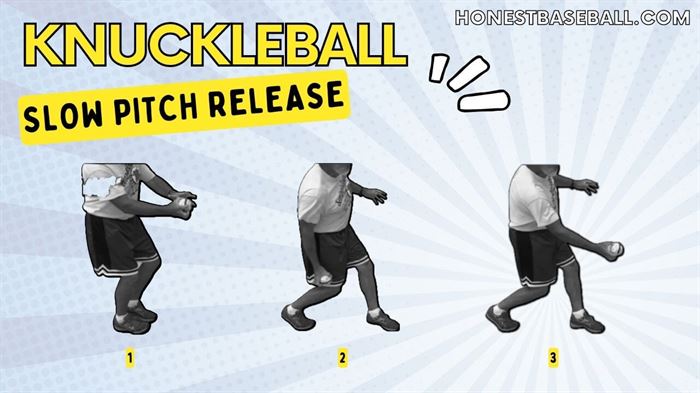
Figure 08- Slow pitch softball knuckleball pitching release method
If talking about the hand motion, keep the wrist straight with the forearm when going back.
And when you are moving forward, follow a pushing motion and maintain the straight motion again. Push a little with all your fingers simultaneously at the end of the release.
How To Slow Pitch Curveball
I always tell the young pitchers to be more serious when learning curveball because this is one of the toughest and most technical pitches.
If you are not doing it correctly, it can stress your arm and elbow. So, learn it at last after gaining the above slow pitches.
Step 1: Grip Of Curveball
Place your 2nd and 3rd finger on the two seams of the ball. Rest the other 1st and 4th fingers right next to them. And lastly, place the thumb finger underneath.
Some pitchers curl the index finger a little. But it is not mandatory. The main goal is to feel your fingers and wrist comfortable during the grip.
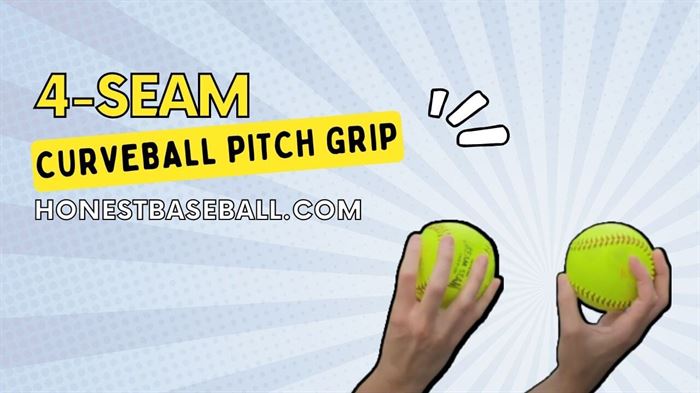
Step 2: Releasing Slow Pitch Curveball
You must ensure good body positioning and movement while pitching curveballs. The curveball pitch goes through your body. So, it is really important to use our legs to help our upper body.
Here is another article on how baseball players improve their leg stability with the help of baseball cheats.
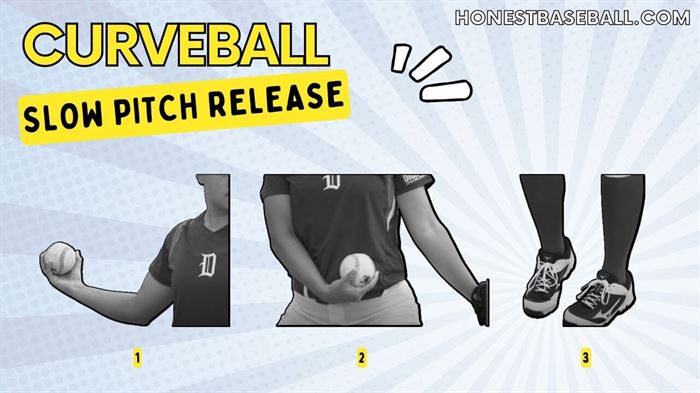
The first thing you need to do is stride onto the powerline. Make sure that your front foot is slightly over to create a sharp angle where you want to throw the pitch.
“Pitchers visualize a line between the plate and the pitching rubber. It is called powerlines.”
As your arms come down towards the release, you should slightly bend your elbow. It will give you firm wrist support and allow you to break it across the body.
In a curveball, you should use your elbow like a hinge on a door, thinking about opening and closing it at a 90-degree angle.
When throwing the curveball, make sure that your spin is tight, and the release point is consistent in front of your body.
For any softball player, a good glove is vital. And Wilson’s gloves are one of my favorites. You can check my advice when choosing Wilson A900 and A1000 gloves in this detailed comparison article.
Frequently Asked Questions
What Makes A Good Slow Pitch Softball Pitcher?
To become a good slow pitch softball pitcher, you need to master two things – gripping and releasing. Also, depending on the type of slow pitching, you need to be skilled in rotation, spin rate control, and controlling the flight height of the ball.
What Is The Hardest Softball Pitch?
Some pitchers may tell you backspin pitching is tough. But in slow pitch softball pitching, the hardest one is the curveball.
It is because the tossing method requires pitchers to maintain the body positioning and high spin rate simultaneously. The throwing method is also a bit unusual.
What’s The Fastest Softball Pitch?
Monica Abbott pocketed the fastest softball pitch record in 2012, 77 mph (123.9 km/h). The match was held between Carolina Diamonds and Chicago Bandits.
Conclusion
In conclusion, slow pitch softball pitching is an art form that takes time to perfect. With the right technique, you can induce ground balls at will and put your opponents on defense.
There are a few things that you can do to improve your slow pitch softball pitching strategy. First, practice regularly and focus on your mechanics.
Second, be patient, learn each slow pitch style at once and let the ball travel. Third, have a game plan and stick to it. Finally, enjoy the game and have fun!

Hello everyone. My name is Jason Butler, and I live in California, America. I was a professional AAA Minor League Baseball player. I lost my chance of playing MLB for injury issues, but I did not lose my love for baseball. I attended the coaching training program and am now working as a coach in a small school in San Diego.
I always love to share my experience and knowledge if that can help you. Play baseball, and stay fit.
